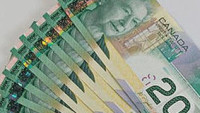 USDCAD has somewhat paused after the pullback from the near 8-month low of 1.2993. The rebound in the price appears to be resting on the mid-Bollinger band at 1.3131, shadowed by a governing bearish structure. The dictating downward sloping 50- and 100-day simple moving averages (SMAs) and the recently completed bearish crossover of the 200-day SMA, may deliver an extra boost to a southward result.
USDCAD has somewhat paused after the pullback from the near 8-month low of 1.2993. The rebound in the price appears to be resting on the mid-Bollinger band at 1.3131, shadowed by a governing bearish structure. The dictating downward sloping 50- and 100-day simple moving averages (SMAs) and the recently completed bearish crossover of the 200-day SMA, may deliver an extra boost to a southward result.
Negative signals continue to reign within the short-term oscillators, backing a deteriorating picture. The stochastic oscillator holds a weakening tone, promoting further losses. The MACD, in the negative region, has pushed above its red signal line and is heading towards zero, while the RSI hovers below its neutral threshold. Yet, noteworthy is the fact that the MACD and the RSI have endured below the 50 mark for an extended period of time.
If sellers manage to push under the mid-Bollinger band at 1.3131, early support may develop from the lower Bollinger band at 1.3030 and the multi-month low of 1.2993 beneath. Should the neighbouring 1.2950 critical border – from December 31 – fail to reinforce the base, the price may dip towards the 1.2884 level, achieved in October 2018. Steeper losses may then eye the 1.2782 and 1.2728 lows, from October and May 2018, respectively.
If buying interest increases, heavy constraints may arise from the 1.3246 to 1.3271 area of highs, which includes the upper Bollinger band and the 50-day SMA. Should buyers overcome this capping section, the price may shoot to the 1.3398 obstacle, before the resistance section of 1.3450 to 1.3490 – where the 100-day SMA also lies – attempts to dismiss the climb. Overrunning this crucial defence, the 200-day SMA at 1.3534 may prevent further advances towards the 1.3600 and 1.3645 tops.
Summarizing, a prevailing bearish bias controls the short-to-medium-term timeframe below 1.3271.

Origin: XM













